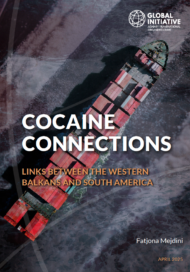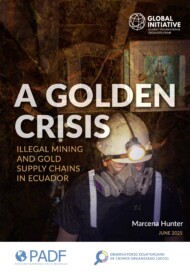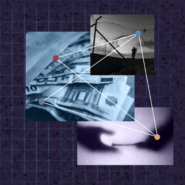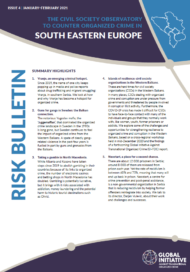Posted on 11 Oct 2025
While the world was grappling with the COVID-19 pandemic and its knock-on effects on global trade, one illicit economy proved stubbornly resilient to the shocks: cocaine trafficking. On 4 November 2020, containers from a ship bound from Paraguay to Israel were cleared at the port of Antwerp in Belgium without arousing suspicion. Soon after, ‘collectors’ arrived at the port to retrieve illicit goods hidden among the vessel’s consignments of coconut soap and plaster adhesive. Beneath this cargo were 12 tonnes of cocaine.
The operation had been orchestrated by an Albanian organized crime network with the capacity to move such vast quantities of the drug that it was able to influence the price of cocaine in European markets.
At the centre of this network were two main figures. Ervis Çela, the broker, secured cocaine in Latin America and organized its shipment to Europe. His counterpart in Belgium was Franc Çopja (who also goes by the surname Gergely), the main financier and recipient, who is considered to be one of the most established Albanian cocaine traffickers. The network operated along the entire supply chain – from financing and securing the cocaine shipment in Bolivia, to shipping it from Paraguay, arranging the paperwork for import of the licit goods to Israel, and ultimately coordinating retrieval of the cocaine at Antwerp’s port.
Decrypted communications from Sky ECC, a messaging network once favoured by criminals, described the Antwerp shipment as record-breaking. Çopja boasted to a collaborator that the 12 tonne consignment was the largest single shipment of cocaine ever to enter Europe, surpassing the previous record of 8.7 tonnes. But the Çela–Çopja clan was eager to break more records. On the same day that they secured the Antwerp shipment, Çopja instructed Çela to dispatch a further 20–30 tonnes of cocaine, and later received confirmation that this had been done.
Two months later, on 21 January 2021, the network successfully retrieved another 8.4 tonnes of cocaine from Antwerp, which had reached Europe on the same route and using the same concealment method. Another shipment was already en route, this time destined for Hamburg in Germany – a hub frequently used by Balkan organized crime groups. This load was even larger, with 16 tonnes of cocaine concealed in tins labelled as acrylic paint. However, on 12 February 2021, that batch was intercepted and seized by German authorities – the largest cocaine seizure recorded in the EU. The authorities estimated its street value to be between €1.5 billion and €3.5 billion.
Despite the setback of the Hamburg seizure, the network remained undeterred. In just three months, they had managed to ship 36.4 tonnes of cocaine to Europe. And Çela had stockpiled a further 22 tonnes in Paraguay, ready for shipment. Still, the group decided to pause operations temporarily in order to better organize their consignments.
In August 2025, Albania’s organized crime unit, known as SPAK (Special Structure on Corruption and Organized Crime), launched an investigation into the drug-related activities of Çela and Çopja, with assistance from EU authorities. In December 2023, Çopja was extradited from the UAE to Belgium, where he is currently in court charged with premeditated murder related to a drug dispute in Brussels in 2020. In June 2025, police arrested Çela in Albania for a murder he had allegedly committed in Italy 17 years ago. Both will also now be charged for their involvement in international drug trafficking. The case is awaiting trial. This is the second drug trafficking case that SPAK has built against Çopja.
How Albanian drug networks work
The Çela and Çopja cases provide insight into the factors that have allowed Albanian drug trafficking networks to become some of the most sophisticated actors in the lucrative cocaine trade.
Over the past decade, Albanian criminal networks have expanded the ambit of their operations from being local players in the cocaine trade into major international wholesalers. Europol’s 2024 assessment of the most threatening criminal networks in the EU flagged Albanians as among the most represented nationalities in cocaine trafficking, alongside Belgians, Dutch, Italians and Spaniards.
A critical component of this transformation has been their activities in Latin America. Their extensive geographical reach and relationships with influential criminal figures in source countries and shipment and transit hubs have given them strategic leverage. The case involving Çela and Çopja is evidence of how they were able to procure large quantities of cocaine in Bolivia, in addition to their established connections in Colombia and Peru. They have also strengthened their position in Ecuador, Brazil and Paraguay – hubs for shipping cocaine from Latin America – through close cooperation with criminal organizations based in those countries.
Another important factor in their rise to criminal success was the infrastructure they established in major European ports and consumption markets. The record-breaking shipments through Antwerp and Hamburg demonstrate the network’s ability to recover large quantities of cocaine from major ports. They were also remarkably efficient wholesalers. According to internal communications on Sky ECC, the 12 tonnes of cocaine retrieved from Antwerp in November 2020 were sold within three weeks, 7.8 tonnes of it in just three days. Decrypted messages also suggest that corruption had facilitated these operations.
Adaptability and pragmatism
The network’s organizational model is based on flexibility and pragmatism. Despite being the the main financier and recipient of his shipments, Çela did not work exclusively with Çopja. Çela allocated portions of each cocaine shipment to associates in Europe and supplied smaller quantities to other Albanian groups operating in the Netherlands, the UK and Italy, as well as to foreign criminal groups. Similarly, Çopja did not rely solely on shipments from Çela; at one point, he mentioned expecting a shipment of 3.5 tonnes from a broker in Colombia.
The financial operations were equally sophisticated. Çela aimed to accumulate €100 million and speculated that Çopja’s wealth had already reached €500 million. They relied on the hawala system – referred to in their code as the ‘token’ – to move funds without physically transferring money across borders. Profits were reinvested in cocaine, as well as in the purchase of planes, villas and farmland in Paraguay and Brazil. Large sums of cash were buried in Paraguay and Albania, to keep it out of the formal banking system’s records. Millions of euros were physically transported through several European countries and hidden in an Albanian village where some of Çela’s family lived. The pair also discussed the advantages of converting the profits into gold, but lamented that this resource was too scarce for their needs – they would have needed hundreds of kilograms of gold.
The sophistication, adaptability and financial power of Albanian criminal networks underscores the need for a more coordinated law enforcement response. The case of Çela and Çopja shows how such groups have become adept at operating seamlessly across borders, exploiting vulnerabilities in ports and the criminal justice system, and leveraging corruption. Combating their influence must include enhanced intelligence sharing, targeted financial investigations and joint efforts to seize assets. Given their entrenched presence in both Latin American supply chains and European markets, it is highly likely that Albanian networks will continue leveraging their reputation and connections to shape the cocaine trade for years to come, posing an ongoing challenge for law enforcement actors across multiple continents.



